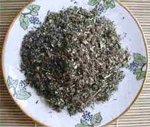How to Use Mugwort
Learn how to use mugwort, and you'll have a wide variety of uses for this unassuming little plant that looks a bit like sage and packs a powerful punch of healing. The word mugwort sound like something straight out of a Harry Potter novel, and in the past, the herb was sometimes used in magical potions, but don't let that deter you; this herb has been respected for centuries for its healing powers.

Photo by Hietaparta at Pixabay
|
Mugwort is definitely an unusual name for an herb, and there are a couple of theories as to how it got its name. |
The plant was once popular as a flavoring for beer; malt liquor was boiled with the dried herb to produce a mug of beer, hence the name: mug - for mug of beer - and wort - for plant.
However, another theory proposes the herb got its name from the word
"moughte" an old English word meaning moth or maggot because the plant
was once considered useful in keeping away moths.
Mugwort is a
member of the artemisia family, a perennial often used to flavor meats
because its smell is similar to sage. The plant has medium green leaves
and a silver underside. The leaves of Mugwort are used, as well as the
roots. Use only the dried leaves of the plant, as the fresh leaves are
considered unsuitable.
How to Use Mugwort for Medicine
Learn how to use mugwort, and you will have medicinal healing in a wide variety of ways. The herb was important to the Chinese to help with digestion and help regulate menstruation, although you should avoid mugwort if you are pregnant, as it could cause a miscarriage.
Mugwort can also help with skin problems. It works as an antiseptic, has skin-cell regenerative properties and is good for healing wounds. Taken as an infusion, it increases perspiration to help your body rid itself of toxins. The infusion is also good for easing nausea.
It is soothing and is known as a nerve tonic and helps suppress muscle spasms. It is also anti-inflammatory and can also be used as an insect repellant. This herb is also good for getting rid of parasites and fungi and will help to cleanse and strengthen the liver.
The Japanese have used this herb in the preparation of Moxa - a medicine usually in the form of cones or sticks that are ignited and placed close to the skin to cure rheumatism. The leaves are heated and rubbed until only the cottony fibers are left and are then made into cones.
According to Dede Cummings and Alyssa Holmes, authors of the book, The Medicinal Gardening Handbook, you can make a dream pillow out of mugwort to enhance dreaming and relaxation. Take a thin, 1 foot square piece of cloth, fold it in half and either hand-sew or machine-sew around the two open edges, leaving one side open. Place in your pillow about 2 cups of dried mugwort, along with one cup each of dried lavender, chamomile and hops. Sew the pillow shut and sleep on it at night.
A Word of Caution When Learning How to Use Mugwort
Not only should you not take it when you're pregnant, you should also be careful when handling the plant as it could cause dermatitis. Do not drink an infusion of the herb before bedtime as it can cause vivid dreams, and even nightmares.
Growing Tips
Mugwort is drought tolerant and will grow in virtually any soil. It has a reputation for being invasive, so if you plant it in your garden, take care to harvest it before it flowers.











New! Comments
Have your say about what you just read! Leave me a comment in the box below.